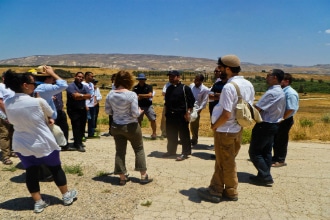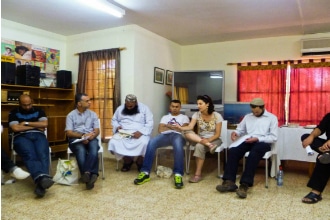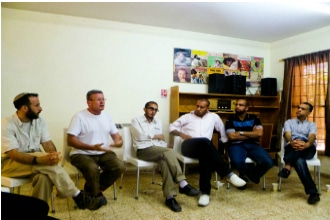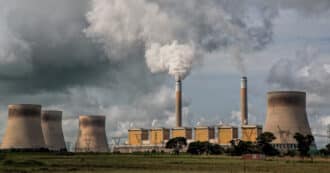By Vanessa Coriat for The Interfaith Center for Sustainable Development
What comes to mind when you think of the “Jordan River”? A body of water surrounded by wild nature? Moses, Jacob, the Biblical prophets? Jesus? Muslim historical ruins? Arab towns? Tourist attraction? Natural borders? Political conflict between neighbors? Turns out it is all of that, and more. On May 30th, 2012, I participated in the “Interfaith Crossing the Jordan Seminar: A Faith-Based Ecological Look at the Jordan River,” a full-day event organized by the Interfaith Center for Sustainable Development (ICSD) in conjunction with Friends of the Earth Middle East (FOEME), Al Qasemi Academy, and Rabbis for Human Rights (RfHR). The seminar was the third in the spring 2012 series of The Interfaith Seminary Students Sustainability Program, bringing together Jewish, Muslim, and Christian seminary students for a series of interactive workshops on faith and ecology in the Holy Land.
Over twenty Jewish, Christian, and Muslim religious studies students – many studying to be rabbis, priests, and imams – joined by already ordained clergy, toured several sites along the northwest bank of the Lower Jordan River. They experienced firsthand the heritage, natural environment, and significance of this river from their respective faith perspectives.
We started the trip in Israel at the Yardenit baptism site, a section of the Lower Jordan River near the Sea of Galilee. Visited by 600,000 people a year, mostly Christian pilgrims, Yardenit is an area of clean water where the faithful can take a dip amidst diverse local fauna and flora. Based on this section of the Jordan River, one might get the impression that the Jordan River remains robust and vibrant from when it exits the Sea of Galilee until it arrives to the Dead Sea.
Our next stop, Alumot, showed that that was not the case. Alumot is a small, man-made dam where a sewage treatment plant is being built. Our guides from FOEME explained that the water flow diverted to the Yardenit baptism site reaches the Alumot dam, and this fresh water is diverted for human consumption, industry, and agriculture. On the southern side of the dam, the liquid that flows in the Lower Jordan River is currently a combination of sewage, agricultural runoff, and saline water. The river’s ecosystem does somewhat clean the effluent as it flows towards the Dead Sea, but by the time it reaches its final destination, it is essentially a small stream of muddy-looking salt water. We learned that the non-native flora along the flow of this effluent have been rapidly replacing the native species and are now threatening the populations of native fauna.
From Alumot we headed to “The Island of Peace.” One of the most amazing sites I’ve ever seen, the Island is land administered by an Israeli kibbutz on Jordanian territory. It is located on the eastern side of the Jordan River, where the Yarmouk River from Jordan meets the Jordan River. At the site, FOEME aims to create a “Jordan River Peace Park.”
We learned about a hydroelectric plant built and founded in the 1930s based on the strong flow of the Jordan and Yarmouk Rivers. Today, however, the Yarmouk River experiences a similar fate as the Jordan River; just as Israel captures or diverts most the water of the Jordan river for human uses, Jordan and Syria divert most of the Yarmouk River.
Next, we had lunch and learned about the Jordan River in the context of the Muslim, Christian, and Jewish traditions. Mufti Dr. Nizar Joron, Professor of Islamic Studies at Al Qassemi Academic College, spoke on the passages in the Islamic tradition where the Jordan River is mentioned. According to Islam, miracles were performed in the Jordan River. In addition, several of the Prophet Muhammad’s companions were buried on the Eastern bank of the Jordan River. Mufti Joron explained how Muslims visit those sites out of respect for the Companions to the Prophet Muhammed but do not pray there. He described how he personally visited these sites.
Next spoke Abbot Gregory Collins, a Catholic priest from Ireland who heads the Dormition Abbey in Jerusalem. He discussed the significance of water in Christianity. His key topics ranged from the meaning of baptism, to the basis for hundreds of thousands of Christian pilgrims visiting the Jordan River every year, to the vitality of water for human life. Jesus was baptized in the Jordan River at the site where the Israelites crossed upon entering the Land of Israel. Therefore, the Jordan River for Christians symbolizes all the rivers and body of waters everywhere in the world.
Rabbi Yonatan Neril, director of the Interfaith Center for Sustainable Development, then led a guided learning session on the passages from the Hebrew Bible that relate to the Jordan River. We learned that Lot saw the banks of the Jordan full of water and life and that the area near the Jordan River was compared to the Garden of Eden. The fifth book of the Hebrew Bible—Deuteronomy—was spoken by Moses as the Israelites were encamped near the banks of the Jordan River. Afterward, God split the Jordan River to allow the Israelites to cross it. The river was split again when the prophets Elija and Elisha wanted to cross it. Elisha also performed two miracles in it. Rabbi Neril emphasized how the vigor and heal powers that the Hebrew Bible describes in relation to the Jordan River can inspire us to promote a healthy future for the river as well.
Concluding a full day of deeply moving experiences, all participants agreed that the symbolism of the Jordan River can promote the Jewish, Christian, and Muslim faithful to actively support the conservation efforts of nature anywhere in the world, and the Jordan River in particular. Many participants were inspired by the proposed “Jordan River Peace Park,” with its potential for intercultural and interreligious exchange, job creation, and ecological benefits.
For me, the seminar was incredibly positive and outstandingly beautiful. Things can change if there are really good and practical reasons for it, and passionate people are committed it to make them happen. The Interfaith Center for Sustainable Development and Ecopeace Middle East are two examples of groups of people with really good reasons and the human force to make it so. The seminar demonstrated how faith and ecology together can form a framework for promoting coexistence. Participants came from diverse faiths and nationalities, and this diversity of backgrounds made for a rich and engaging experience.
So what comes to mind when I think “Jordan River”? A strong flow of peaceful and beautiful possibilities.















